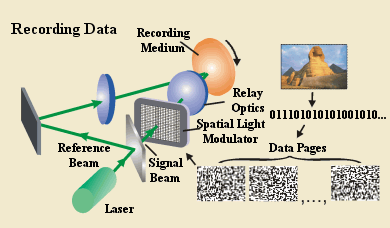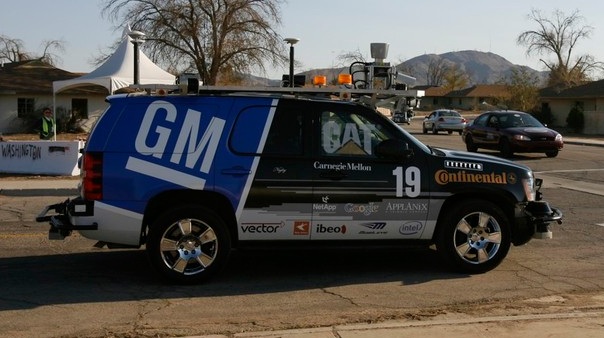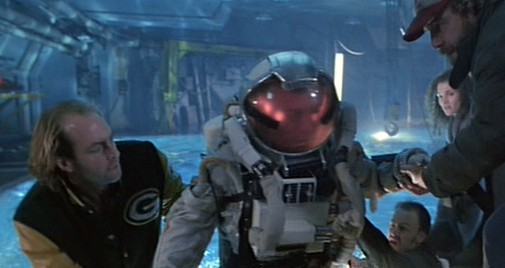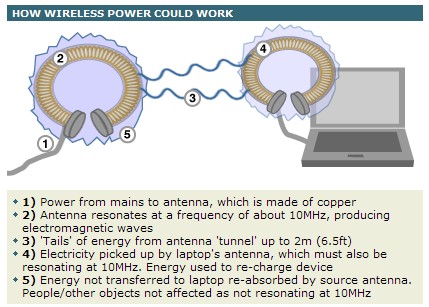In Pictures: Upcoming Technologies We Want Right Now
Holographic Data Storage
Holographic Data Storage
Holographic data storage involves a different approach compared to today's standard disk- and flash-based processes, recording data throughout the volume of a thick, photosensitive optical material. Once perfected, this method could allow for recording multiple images--perhaps thousands--in the same space by placing the laser at different angles.
For recording, the laser is split into a reference and a data-carrying beam. The latter essentially picks up information arranged in a checkerboard pattern as it passes through a spatial light modulator. It then interferes with the reference beam through the material, storing the data. A good explanation of how holographic data is manipulated can be found here, at Lucent Technologies' Bell Laboratories Web site.
Volumetric 3D Display
Volumetric 3D Display
The idea behind a volumetric 3D display is to present images that appear to have three physical dimensions, regardless of the viewpoint. This is a completely different approach than the current method of converting flat, 2D images, and then using special glasses or multiple screens to trick the naked eye.
Volumetric 3D images would not only appear solid from one point of view--as in standing directly in front of the display--but would look the same when moving around the display a full 360 degrees. While this technology doesn't offer 3D visuals that literally reach out to your face, volumetric 3D displays in the living room would mean a more realistic experience.
In October 2009, Sony revealed such a device, although it was rather small. Viewers watched the object rotate within the display or walked around the device to see the object in its entirety, as if it stood within a virtual cage.
Get Tom's Hardware's best news and in-depth reviews, straight to your inbox.
Self-Driving Automobiles
Self-Driving Automobiles
Self-driving vehicles would be part of that evolutionary step from pre-programmed AI to cognitive mechanics. These vehicles would still require the rider to physically interact with the car. But instead of driving, the pilot would merely step in and select a destination with an oral command. The vehicle would then deliver the rider using an auto-pilot system.
This would mean that the AI would need to have complex cognitive skills in order to make quick decisions, such as avoiding lost puppies wandering around in the middle of the road or letting the rider exit the vehicle while in motion. According to General Motors, the first driverless car could be on the road by 2018. The company revealed its plans a few years back, and said it would begin testing by 2015. Former General Motors Chief Executive Rick Wagoner said the biggest hurdle wouldn't be the technology, but rather liability laws and government regulations. “This is not science fiction,” Larry Burns, GM’s vice president for research and development, said in 2008. Since the report, other car manufacturers, including Nissan, Honda, and Audi have begun development of automated cars.
Augmented Reality
Augmented Reality
We've seen some augmented-reality applications already begin to take shape. But what if it was standard technology, embedded in your sunglasses? Wherever you went, whether it would be on foot, in an automobile, or even on a bicycle, you would receive information relevant to your surroundings. Need to find a local toilet? An augmented-reality device could show you where. Have you wandered too far in the woods? An enabled device could point you in the right direction, drawing an actual virtual road on the ground right beneath your feet. We previously reported on plans in the automotive market to install augmented-reality technology in windshields and rear-view mirrors. Connected to an onboard computer, the augmented-reality fields would display most of what you would find on a normal dashboard, along with weather conditions, distance to your destination, the distance to the next car, and more.
Hardcore Virtual Gaming
Hardcore Virtual Gaming
This really should need no explanation--we've seen examples of virtual gaming in various sci-fi movies and TV shows. Although 3D is slowly starting to creep into our PC and console titles, virtual gaming is already taking shape on a more engrossing level. A good example is the Virtusphere, which allows players to climb inside, don special glasses, and virtually walk and run during the game. One day we'd like to see a real holodeck-like experience, allowing us to play games in artificial, replicated environments without the need for special glasses or other connected devices. In the meantime, this small step will certainly do.
Atomic Memory
Atomic Memory
Imagine if you could store a bit of data--binary zero or binary one--on one individual atom. Now imagine a grain of sand composed of trillions of binary bits of information stored on each atom--a definite far cry from using millions of atoms just to store one bit of data. The idea of atomic memory has been around since the late 1950s, while scientists have been able to move closer to atomic storage during the past 10 years. By 2001, scientists were able to store one bit of data on a single atom, but it had to be shielded from its neighboring atoms by placing it within a five-by-four cell of atoms. The end result took 20 atoms to secure one bit of data. Close, but not the 1:1 ratio scientists eventually want to achieve.
Shape-Changing Alloys
Shape-Changing Alloys
Shape-changing alloys could be a good or bad thing. On one hand, the technology could make automation quick and simple. For example, developing an alloy that could shape itself into a particular component, whether that would be an army knife or a key part in an automobile engine. On the other hand, this could eliminate jobs by making hand-crafted work redundant.
However, the shape-changing technology is already in existence, developed by scientists at Harvard and MIT. In its present state, the shape-changing alloy is folding sheets into small shapes like boats and airplanes. But that's merely the beginning. Could it be possible to use the technology to build real boats and airplanes within the next 10 years?
Home-Based Nuclear Generators
Home-Based Nuclear Generators
In 2007, Toshiba revealed plans to sell nuclear reactors for every home across the globe based on a prototype it had developed. Measuring 20 by six feet, the 200 KW generator was fail-safe, fully automatic, self-sustaining, and could even serve the power needs of entire city blocks, Toshiba said.
Instead of traditional control rods, the personal reactor used special liquid-lithium reservoirs so it could last up to 40 years and, once commercialized, would cost consumers around 5 cents per KW/h of electricity consumed. For whatever reason, the device has not reached homes yet. However, earlier this year, Bill Gates (via TerraPower) announced a possible joint venture with Toshiba to refine and develop the original design. Gates' technology was said to run without refueling for up to 60 years on depleted uranium. Future generators are expected to be safer, smaller, and more socially acceptable than what Toshiba originally had in mind. Unfortunately, the technology isn't expected to go commercial until the early 2020s.
Petroleum-Free Automobiles
Petroleum-Free Automobiles
After the recent BP spill in the Gulf of Mexico, it's clearer than ever that our dependence on fossil fuels needs to be at least partially alleviated by alternative energy sources. We've already seen hybrid vehicles enter the market, utilizing conventional fuels and electricity.
However, gas consumption isn't the only factor--manufacturers use petroleum during the process of building automobile parts. Recently, Ford revealed its aim to eliminate petroleum altogether in its processes by using bio-based soy foam. According to Debbie Mielewski, Ford technical leader of plastics research, the company conserves around 1.5 million pounds of petroleum annually when using soy-based foam to manufacture parts. "While these numbers are not big compared to the burning of fuel, we think that everything we can do, without compromising performance and durability, moves us in the right direction for the long term," Mielewski said.
Liquid Breathing
Liquid Breathing
The idea behind liquid breathing is to allow humans to venture into the depths of the ocean--or even the cold black void of space--without the need to breathe air in gas form. Instead, explorers would wear a device that pumps oxygen-rich liquids into the lungs. This could help mitigate some of the pressure-based challenges encountered by divers in deep water and the problems associated with returning to the surface.
In the medical field, the application is already in use--premature babies born with underdeveloped lungs have used liquid breathing to stay alive until their lungs are capable of taking in air. Liquid breathing has also been used to help adults with acute respiratory failure.
Wireless Energy
Wireless Energy
The concept of wireless energy came about during the late 1800s, while an article featured on Space.com sparked an interest with mainstream media as it discussed wireless energy transfers in space. Now, 10 years later, we've recently reported on devices in development that actually do recharge and power other devices without the need for cables and wires.
The process works by plugging a copper coil into a wall outlet while another copper coil is plugged into an electronic device. Both coils are tuned to the same frequency. The wall coil generates an electromagnetic field and resonates with the device coil. This resonant coupling is what generates the energy for the device. But don't fret--this process isn't harmful to humans, as apparently our bodies don't respond to magnetic fields in a negative way. Much like WiFi is now available in restaurants, gas stations, book stores, and many other public places, resonant coupling is expected to be just as abundant. Many companies are expected to hit the market with wireless power technology by the second quarter of 2011.

Kevin Parrish has over a decade of experience as a writer, editor, and product tester. His work focused on computer hardware, networking equipment, smartphones, tablets, gaming consoles, and other internet-connected devices. His work has appeared in Tom's Hardware, Tom's Guide, Maximum PC, Digital Trends, Android Authority, How-To Geek, Lifewire, and others.
-
Ramar "On the other hand, this could eliminate jobs by making hand-crafted work redundant."Reply
Shouldn't Tom's, of all people, understand what's wrong with this statement?
As a starter: Technology and the advancement of our race should take precedence over any particular job field. Sure, the horse-buggy builders had some tough years learning to work at the Ford factory, but that's how life is.
Great article otherwise though, thanks guys! :) -
Rancifer7 ReplyThe concept of wireless energy came about during the late 1800s, while an article featured on Space.com sparked an interest with mainstream media as it discussed wireless energy transfers in space.
late 1800s..who knew...
And here I thought the internet and space travel were a more recent thing... -
@Rancifer7 Look up Nikola Tesla's disturbed charge of ground and air system and Wardenclyffe Tower. It's been around for ages but it got buried for financial interests.Reply
-
liquidsnake718 Self driving autos would only work on high tech and small cities with all the wifi and proper roads available. The last S class Mercedes had motion sensing rear and front bumpers that would sense an object and would slow the car down via auto brakes, this tech can also be implimented with a smarter cpu and video cameras to tell the actual distance and colors from stop lights, or perhaps can be controlled by the stop light somehow. Thiswould work in an entirely new and modern city or a city like toyko, singapore, New York, or Paris where the roads are linear and is full of tech and cameras.Reply -
Drayeon liquidsnake. Check out the Darpa challenges. The one back in 2007 had the vehicles drive over 200 miles. Have other vehicles on the road. And obstacles such as people and various other things that could go on the road. (Fallen tree limbs). The vehicles would either have to reroute to different roads or lose. This took place in rural and urban settings over 200 miles without any support from people.Reply
If the vehicles could do that then I wonder what they could do now. It is true that really most of whats holding this back is regulation and litigation issues.I wish the Darpa challenges were still being held but, I guess they got what they wanted. -
killerclick Yeah, who needs volumetric 3d displays if we know we're going to get old and die. Immortality!Reply -
@Drayeon you might also be interested in this event taking place right now http://viac.vislab.itReply










